At the mercy of the mob
Here are some notorious examples of the use of the pillory. Its victims range from the infamous to the obscure, some perhaps more deserving of the pillory than others.
Perkin Warbeck
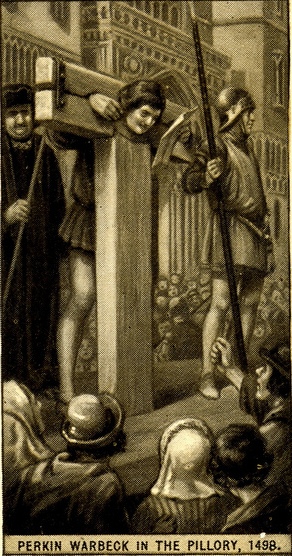
Warbeck was a pretender to the English throne, who claimed to be the son of King Edward IV. Warbeck was captured and imprisoned in the Tower of London
after a failed attempted to depose King Henry VII
in 1497. Following an unsuccessful escape attempt, Henry ordered that "the knave should be taken out and set in the stocks".
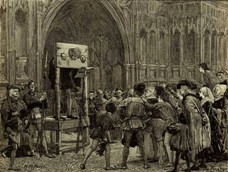 Accordingly, on 14 June 1499,
Warbeck was exposed in the pillory in the Palace Court, Westminster. He was pilloried again the following day at the Cross on Cheapside, and at
both these places he was obliged read aloud a confession that he was an impostor. Warbeck was again imprisoned in the Tower of London and,
after another failed attempt at escape later in the same year, publicly hanged.
Accordingly, on 14 June 1499,
Warbeck was exposed in the pillory in the Palace Court, Westminster. He was pilloried again the following day at the Cross on Cheapside, and at
both these places he was obliged read aloud a confession that he was an impostor. Warbeck was again imprisoned in the Tower of London and,
after another failed attempt at escape later in the same year, publicly hanged.
Elizabeth Cellier
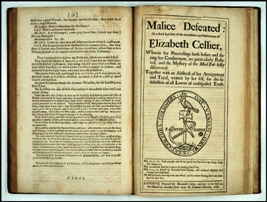 Elizabeth Cellier is now best known as a 17th century pioneer of female midwives, a specialism previously monopolised by male doctors. This did not endear her to the Establishment, particularly as she was also a Catholic. In 1680, Mrs Cellier was implicated in an alleged Catholic conspiracy to assassinate the King and other high profile Protestants. She was acquitted of that charge, but she then published a pamphlet entitled "Malice Defeated, or, a Brief Relation of the Accusation and Deliverance of Elizabeth Cellier". This was an account of her trial in which she claimed that Catholics were being tortured in Newgate prison. She was brought to court again, and this time found guilty of libel. According to the trial records, Mrs Cellier's sentence was:
Elizabeth Cellier is now best known as a 17th century pioneer of female midwives, a specialism previously monopolised by male doctors. This did not endear her to the Establishment, particularly as she was also a Catholic. In 1680, Mrs Cellier was implicated in an alleged Catholic conspiracy to assassinate the King and other high profile Protestants. She was acquitted of that charge, but she then published a pamphlet entitled "Malice Defeated, or, a Brief Relation of the Accusation and Deliverance of Elizabeth Cellier". This was an account of her trial in which she claimed that Catholics were being tortured in Newgate prison. She was brought to court again, and this time found guilty of libel. According to the trial records, Mrs Cellier's sentence was:
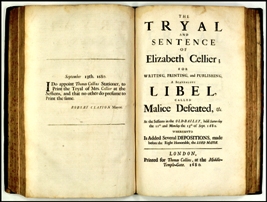 "She is Fined one Thousand pound to the King, to be kept in Prison till that be paid; she is to stand Three several times in the Pillory, First, by the May-pole in the Strand, Secondly, in Convent-garden [Covent Garden], Thirdly, at Charing-cross; her Books being to be Burnt in her view; and after to find Sureties for her good Behaviour during Life."
"She is Fined one Thousand pound to the King, to be kept in Prison till that be paid; she is to stand Three several times in the Pillory, First, by the May-pole in the Strand, Secondly, in Convent-garden [Covent Garden], Thirdly, at Charing-cross; her Books being to be Burnt in her view; and after to find Sureties for her good Behaviour during Life."
According to contemporary records:
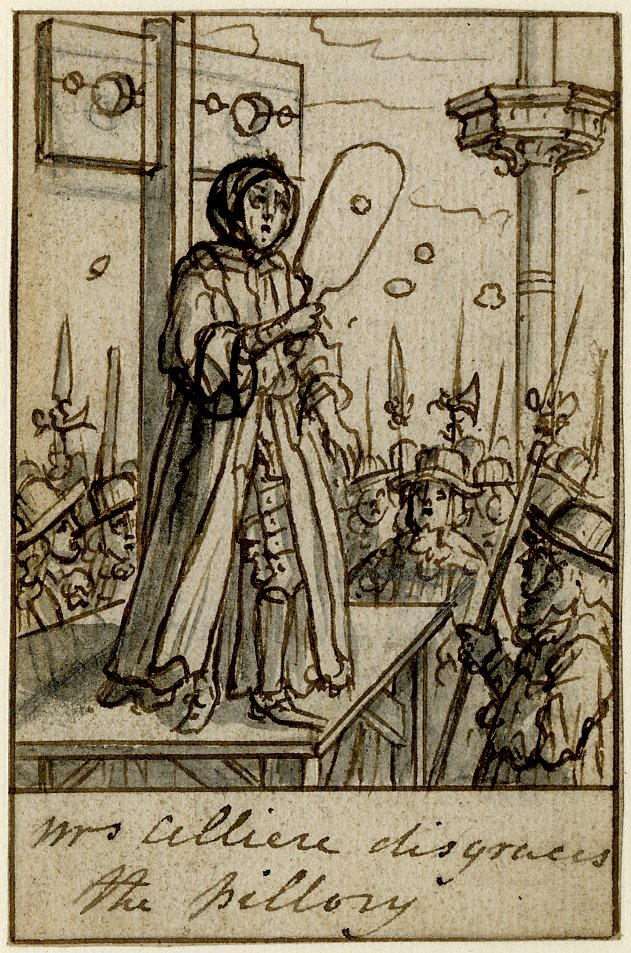 "Mrs. Cellier stood on the pillory at the Maypole today [10 September 1680]. She was much pelted but not hurt."
When she was pilloried again [on 20 September 1680] "...she had been hauled out of bed, though she could not rise, set on the pillory, twice struck down with stones by the rabble but lifted up again by the sheriff's officers, and had been kept there till 2 o'clock, though her sentence was to remain only between 12 and 1. She had been grievously bruised and, several officers had been wounded in her defence."
"Mrs. Cellier stood on the pillory at the Maypole today [10 September 1680]. She was much pelted but not hurt."
When she was pilloried again [on 20 September 1680] "...she had been hauled out of bed, though she could not rise, set on the pillory, twice struck down with stones by the rabble but lifted up again by the sheriff's officers, and had been kept there till 2 o'clock, though her sentence was to remain only between 12 and 1. She had been grievously bruised and, several officers had been wounded in her defence."
After she had been pilloried three times, Mrs Cellier was imprisoned until she could pay the £1,000 fine. She was eventually released from prison in 1687. The following year Mrs Cellier published a controversial pamphlet that argued for the value of midwives’ practical experience over the theoretical knowledge of male physicians. She also advocated the formation of the Royal College of Midwives.
Benjamin Keach
 Benjamin Keach was a Baptist minister who was brought to trial on 9 October 1664. His offence was that he had published a book ("The Child's Instructor"), in which he had disputed the Church of England's doctrine on infant baptism.
Benjamin Keach was a Baptist minister who was brought to trial on 9 October 1664. His offence was that he had published a book ("The Child's Instructor"), in which he had disputed the Church of England's doctrine on infant baptism.
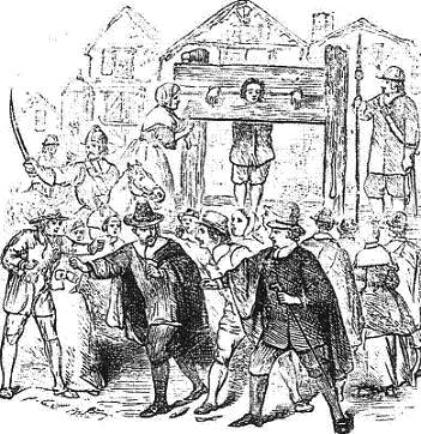 Keach was found guilty of publishing a "seditious and schismatical book". He was fined £20 and imprisoned "until you find sureties for your good behaviour and appearance at the next assizes, there to renounce your doctrines and make such public submission as shall be enjoined upon you". He was also sentenced to be pilloried in Aylesbury for two hours, followed by a further two hours in the pillory at Winslow, and "then your book shall be openly burnt before your face by the common hangman in disgrace of you and your doctrine".
Keach was found guilty of publishing a "seditious and schismatical book". He was fined £20 and imprisoned "until you find sureties for your good behaviour and appearance at the next assizes, there to renounce your doctrines and make such public submission as shall be enjoined upon you". He was also sentenced to be pilloried in Aylesbury for two hours, followed by a further two hours in the pillory at Winslow, and "then your book shall be openly burnt before your face by the common hangman in disgrace of you and your doctrine".
Keach continued to preach from the pillory, provoking the sheriff to threaten to have him gagged. However the crowd were sympathetic to Keach, and not a single missile was thrown at him. A priest who attempted to rebuke Keach for his heresy was shouted down by the mob.
Titus Oates
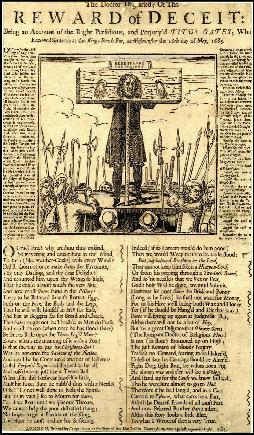 Titus Oates invented a "popish plot", a fictitious conspiracy by catholics to overthrow King Charles II.
As a result of his unfounded accusations, a number of innocent people were executed. When he was found out,
Titus Oates was deemed to merit prolonged punishment.
Titus Oates invented a "popish plot", a fictitious conspiracy by catholics to overthrow King Charles II.
As a result of his unfounded accusations, a number of innocent people were executed. When he was found out,
Titus Oates was deemed to merit prolonged punishment.
According to Chambers Book of Days:
"Found guilty of perjury on two separate indictments, the inventor of the Popish Plot was condemned in 1685 to public exposure [in the pillory] on three consecutive days. The first day's punishment in Palace Yard nearly cost the criminal his life; but his partisans mustered in such force in the city on the succeeding day that they were able to upset the pillory, and nearly succeeded in rescuing their idol from the hands of the authorities.
According to his sentence, Oates was to stand every year of his life in the pillory on five different days: before the gate of Westminster Hall on the 9th of August, at Charing Cross on the 10th, at the Temple on the 11th, at the Royal Exchange on the 2nd of September, and at Tyburn on the 24th of April; but, fortunately for the infamous creature, the Revolution deprived his determined enemies of power, and turned the criminal into a pensioner on Government."
Here is a transcript of the court's sentence upon Titus Oates:
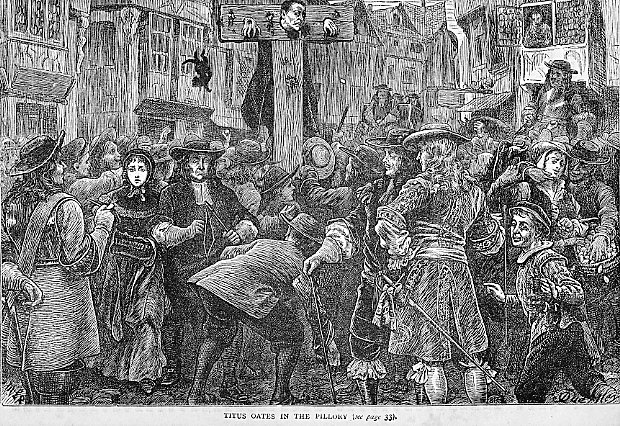 "First, The Court does order for a fine, that you pay 1000 marks upon each Indictment.
Secondly, That you be stript of all your Canonical Habits.
Thirdly, the Court does award, That you do stand upon the Pillory, and in the Pillory, here before Westminster-hall gate, upon Monday next, for an hour's time, between the hours of 10 and 12; with a paper over your head (which you must first walk with round about to all the Courts in Westminister-hall) declaring your crime. And that is upon the first Indictment.
"First, The Court does order for a fine, that you pay 1000 marks upon each Indictment.
Secondly, That you be stript of all your Canonical Habits.
Thirdly, the Court does award, That you do stand upon the Pillory, and in the Pillory, here before Westminster-hall gate, upon Monday next, for an hour's time, between the hours of 10 and 12; with a paper over your head (which you must first walk with round about to all the Courts in Westminister-hall) declaring your crime. And that is upon the first Indictment.
Fourthly, (on the Second Indictment), upon Tuesday, you shall stand upon, and in the Pillory, at the Royal Exchange in London, for the space of an hour, between the hours of twelve and two; with the same inscription.
You shall upon the next Wednesday be whipped from Aldgate to Newgate.
Upon Friday, you shall be whipped from Newgate to Tyburn, by the hands of the common hangman.
But, Mr. Oates, we cannot but remember, there were several particular times you swore false about; and therefore, as annual commemorations, that it may be known to all people as long as you live, we have taken special care of you for an annual punishment.
Upon the 24th of April every year, as long as you live, you are to stand upon the Pillory and in the Pillory, at Tyburn, just opposite to the gallows, for the space of an hour, between the hours of ten and twelve.
You are to stand upon, and in the Pillory, here at Westminster-hall gate, every 9th of August, in every year, so long as you live. And that it may be known what we mean by it, 'tis to remember, what he swore about Mr. Ireland's being in town between the 8th and 12th of August.
You are to stand upon, and in the Pillory, at Charing-cross, on the 10th of August, every year, during your life, for an hour, between ten and twelve.
The like over-against the Temple gate, upon the 11th.
And upon the 2nd of September, (which is another notorious time, which you cannot but be remember'd of) you are to stand upon, and in the Pillory, for the space of one hour, between twelve and two, at the Royal Exchange; and all this you are to do every year, during your life; and to be committed close prisoner, as long as you live."
Its possible that the severity of this punishment was designed to kill Oates by ill-treatment, as the trial judge openly regretted that he could not impose the death penalty in a case of perjury.
Oates was reprieved in 1689 following the accession of King William III and Queen Mary II. He died in obscurity in 1705.
John Lingard
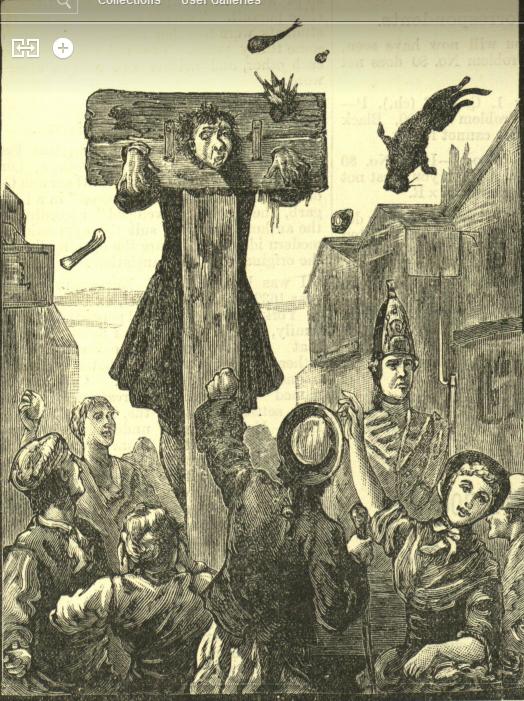 Perjury (lying in court) was a detested crime. As there were so many offences which carried the death penalty, perjury was perceived as little better than murder. So perjurers like John Lingard could expect little mercy in the pillory.
Perjury (lying in court) was a detested crime. As there were so many offences which carried the death penalty, perjury was perceived as little better than murder. So perjurers like John Lingard could expect little mercy in the pillory.
According to the records of the Old Bailey criminal court, on 18 April 1752: “A few minutes after twelve at noon, Lingard, found guilty of perjury in swearing Mr Coleman’s life away, was brought from the New Gaol to the pillory, near St George’s church, Southwark, where the executioner was several minutes before he could get his head fix’d; as soon as he had done his business and left the scaffold, the people, who universally expressed their detestation and abhorrence of the criminal, began their attack upon him in a very furious manner, by throwing at him mud, stones, and sticks, so that it was imagined he would not get off alive; however, the mob, which was very great, moderated their rage, and though the pelting never entirely ceased, it, at last, considerably abated.
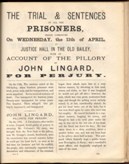 Lingard got his head twice out of the hole, but it was soon fixed again by some who used him but roughly. He waved his hands in a suppliant manner, begging for mercy, and though he had a tin scull plate under his cap, he was cut in the left side of his head, and the blood ran down his face. He was taken down in a dirty condition, about a quarter before one, and had not been kept in the pillory above half an hour. This perjured villain formerly kept a public house near Newington, in Surry; was a marshall’s court officer, and frequently employed as a crier of the court.”
Lingard got his head twice out of the hole, but it was soon fixed again by some who used him but roughly. He waved his hands in a suppliant manner, begging for mercy, and though he had a tin scull plate under his cap, he was cut in the left side of his head, and the blood ran down his face. He was taken down in a dirty condition, about a quarter before one, and had not been kept in the pillory above half an hour. This perjured villain formerly kept a public house near Newington, in Surry; was a marshall’s court officer, and frequently employed as a crier of the court.”
John Waller
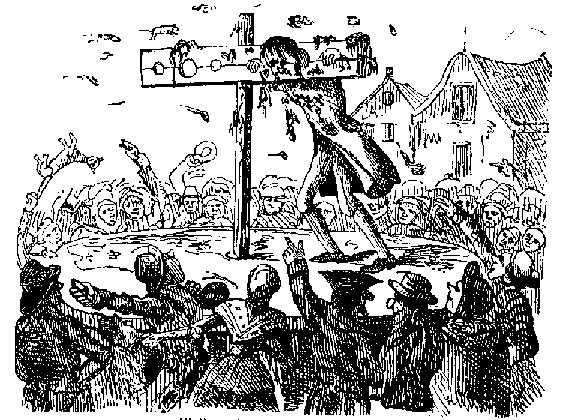 Here is a contemporary newspaper account of the fate of John Waller, who was convicted of robbery and perjury:
Here is a contemporary newspaper account of the fate of John Waller, who was convicted of robbery and perjury:
"Pilloried for perjury, and pelted to death by the populace, 13th June, 1732
This profligate wretch, Waller, to robbery added the still greater sin of accusing the innocent, in order to receive the reward in certain cases attending conviction. The abominable dealer in human blood was tried at the Old Bailey for robbing, on the highway, one John Edglin, and afterwards, under the name of John Trevor, giving a false evidence against the said John Edglin, whereby his life might have become forfeited to the abused laws of the country. On the latter charge he was found guilty.
It appeared, on this memorable trial, that Waller made it a practice to go the circuits as regularly as the judges and counsel, and to swear robberies against such as he deemed fit objects for his purpose, from no other motive than to obtain the reward given by each county for the apprehension and conviction of criminals for highway robberies and other offences therein committed.
The sentence of the Court was, that he should pay a fine of twenty marks, and be imprisoned for the term of two years, and at the expiration thereof to find good and sufficient security for his good behaviour during the remainder of his life; that he do stand twice in and upon the pillory, bareheaded, with his crime written in large characters; and that he do also stand twice before the pillory, likewise bareheaded, one hour each time.
On Tuesday, the 13th of June, 1732, this wicked man was put in the pillory, pursuant to his sentence, at the Seven Dials, in London; where, so great was the indignation of the populace, that they pelted him to death and the day after the coroner's inquest gave a verdict, 'Wilful murder by persons unknown.'"
Eleanor Beare
On 18 August 1732, Eleanor Beare was tried in Derby for performing illegal abortions, and inciting a man
to murder his wife (for which Eleanor supplied him with poison). Here is a transcript of Eleanor's trial.
According to The Gentleman's Magazine, "his Lordship summed up the Evidence in a very moving Speech to the Jury,
wherein he said, he never met with a
Case so barbarous and unnatural. The Jury, after a short Consultation, brought the Prisoner in Guilty of both
Indictments, and she received Sentence to stand in the Pillory, the Two next Market-Days, and to suffer dole
Imprisonment for Three Years."
Here are a selection of contemporary reports describing Eleanor's adventures in (and out of) the pillory:
"This Day Eleanor Beare, pursuant to her Sentence, stood for the first Time in the Pillory in the Marketplace;
to which Place she was attended by several of the Sheriff's Officers; notwithstanding which, the Populace, to
show their Resentment of the horrible Crimes wherein she has been charged, and the little Remorse she had shown
since her Commitment, gave her no Quarter, but threw such quantities of Eggs, Turnips, Etc. that it was thought
she would hardly have escap'd with her Life: She disengaged herself from the Pillory before her the Time of her
standing was expired, and jump'd among the Crowd, whence she was with Difficulty carried back to Prison."
"I saw her, August 18, 1732, with an easy air ascend the hated machine, which overlooked an enraged multitude. All the apples, eggs, and turnips, that could be bought, begged, or stolen, were directed at her devoted head. The stagnate kennels were robbed of their contents, and became the cleanest part of the street. The pillory, being out of repair, was unable to hold a woman in her prime, whose powers were augmented by necessity; she released herself; and, jumping among the crowd, with the resolution and agility of an amazon, ran down the Morlege, being pelted all the way; new kennels produced new ammunition; and she appeared a moving heap of filth. With difficulty they remounted her......by the time they had fixed her, the hour expired, and she was carried to prison, an object which none cared to touch."
"The next week she was again brought out of prison, and again pilloried. As soon as she mounted the platform, she kneeled down
and begged mercy of the still outrageous mob. The executioner finding, from her struggling, some difficulty in getting her head
through the hole of the pillory, pulled off her head-dress, and therein found a large pewter plate, beat out so as to fit her
head, which he threw among the, spectators. As soon as she was fixed, a shower of eggs, potatoes, turnips, &c. assailed her from
every direction; and it was thought she would not be taken down alive. Having expended all the ammunition of the above description,
stones were thrown, which wounded her to such a degree, that her blood streamed down the pillory. This somewhat appeased the
resentment shewn against her, and she was returned to gaol a shocking spectacle to behold."
"The next Friday she appeared again not as a young woman, but an old one, ill, swelled, and decrepid; she seemed to have advanced thirty years in one week. The keeper suspecting some finesse from the bulk of her head, took off ten or twelve coverings, among which was a pewter plate, fitted to the head, as a guard against the future storm. He tossed it among the crowd, and left no covering but the hair. The pillory being made stronger, and herself being weaker, she was fixed for the hour; where she received the severe peltings of the mob; and they, her groans and her prayers. She afterwards sustained the three years imprisonment, recovered her health, her spirits, and her beauty; and at her enlargement [release from prison] was preceded by a band of music."

[Return to index page]
Last modified 3 June 2021.
Copyright © StocksMaster. All rights reserved.
 Accordingly, on 14 June 1499,
Warbeck was exposed in the pillory in the Palace Court, Westminster. He was pilloried again the following day at the Cross on Cheapside, and at
both these places he was obliged read aloud a confession that he was an impostor. Warbeck was again imprisoned in the Tower of London and,
after another failed attempt at escape later in the same year, publicly hanged.
Accordingly, on 14 June 1499,
Warbeck was exposed in the pillory in the Palace Court, Westminster. He was pilloried again the following day at the Cross on Cheapside, and at
both these places he was obliged read aloud a confession that he was an impostor. Warbeck was again imprisoned in the Tower of London and,
after another failed attempt at escape later in the same year, publicly hanged.

 Elizabeth Cellier is now best known as a 17th century pioneer of female midwives, a specialism previously monopolised by male doctors. This did not endear her to the Establishment, particularly as she was also a Catholic. In 1680, Mrs Cellier was implicated in an alleged Catholic conspiracy to assassinate the King and other high profile Protestants. She was acquitted of that charge, but she then published a pamphlet entitled "Malice Defeated, or, a Brief Relation of the Accusation and Deliverance of Elizabeth Cellier". This was an account of her trial in which she claimed that Catholics were being tortured in Newgate prison. She was brought to court again, and this time found guilty of libel. According to the trial records, Mrs Cellier's sentence was:
Elizabeth Cellier is now best known as a 17th century pioneer of female midwives, a specialism previously monopolised by male doctors. This did not endear her to the Establishment, particularly as she was also a Catholic. In 1680, Mrs Cellier was implicated in an alleged Catholic conspiracy to assassinate the King and other high profile Protestants. She was acquitted of that charge, but she then published a pamphlet entitled "Malice Defeated, or, a Brief Relation of the Accusation and Deliverance of Elizabeth Cellier". This was an account of her trial in which she claimed that Catholics were being tortured in Newgate prison. She was brought to court again, and this time found guilty of libel. According to the trial records, Mrs Cellier's sentence was: 
 "Mrs. Cellier stood on the pillory at the Maypole today [10 September 1680]. She was much pelted but not hurt."
When she was pilloried again [on 20 September 1680] "...she had been hauled out of bed, though she could not rise, set on the pillory, twice struck down with stones by the rabble but lifted up again by the sheriff's officers, and had been kept there till 2 o'clock, though her sentence was to remain only between 12 and 1. She had been grievously bruised and, several officers had been wounded in her defence."
"Mrs. Cellier stood on the pillory at the Maypole today [10 September 1680]. She was much pelted but not hurt."
When she was pilloried again [on 20 September 1680] "...she had been hauled out of bed, though she could not rise, set on the pillory, twice struck down with stones by the rabble but lifted up again by the sheriff's officers, and had been kept there till 2 o'clock, though her sentence was to remain only between 12 and 1. She had been grievously bruised and, several officers had been wounded in her defence."  Benjamin Keach was a Baptist minister who was brought to trial on 9 October 1664. His offence was that he had published a book ("The Child's Instructor"), in which he had disputed the Church of England's doctrine on infant baptism.
Benjamin Keach was a Baptist minister who was brought to trial on 9 October 1664. His offence was that he had published a book ("The Child's Instructor"), in which he had disputed the Church of England's doctrine on infant baptism.  Keach was found guilty of publishing a "seditious and schismatical book". He was fined £20 and imprisoned "until you find sureties for your good behaviour and appearance at the next assizes, there to renounce your doctrines and make such public submission as shall be enjoined upon you". He was also sentenced to be pilloried in Aylesbury for two hours, followed by a further two hours in the pillory at Winslow, and "then your book shall be openly burnt before your face by the common hangman in disgrace of you and your doctrine".
Keach was found guilty of publishing a "seditious and schismatical book". He was fined £20 and imprisoned "until you find sureties for your good behaviour and appearance at the next assizes, there to renounce your doctrines and make such public submission as shall be enjoined upon you". He was also sentenced to be pilloried in Aylesbury for two hours, followed by a further two hours in the pillory at Winslow, and "then your book shall be openly burnt before your face by the common hangman in disgrace of you and your doctrine". 
 "First, The Court does order for a fine, that you pay 1000 marks upon each Indictment.
Secondly, That you be stript of all your Canonical Habits.
Thirdly, the Court does award, That you do stand upon the Pillory, and in the Pillory, here before Westminster-hall gate, upon Monday next, for an hour's time, between the hours of 10 and 12; with a paper over your head (which you must first walk with round about to all the Courts in Westminister-hall) declaring your crime. And that is upon the first Indictment.
"First, The Court does order for a fine, that you pay 1000 marks upon each Indictment.
Secondly, That you be stript of all your Canonical Habits.
Thirdly, the Court does award, That you do stand upon the Pillory, and in the Pillory, here before Westminster-hall gate, upon Monday next, for an hour's time, between the hours of 10 and 12; with a paper over your head (which you must first walk with round about to all the Courts in Westminister-hall) declaring your crime. And that is upon the first Indictment.  Perjury (lying in court) was a detested crime. As there were so many offences which carried the death penalty, perjury was perceived as little better than murder. So perjurers like John Lingard could expect little mercy in the pillory.
Perjury (lying in court) was a detested crime. As there were so many offences which carried the death penalty, perjury was perceived as little better than murder. So perjurers like John Lingard could expect little mercy in the pillory.

 Here is a contemporary newspaper account of the fate of John Waller, who was convicted of robbery and perjury:
Here is a contemporary newspaper account of the fate of John Waller, who was convicted of robbery and perjury: 